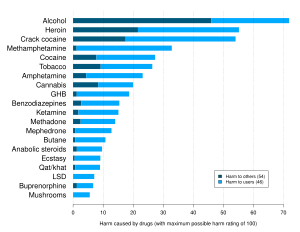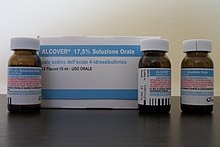Alcohol detoxification

Alcohol detoxification (also known as detox) is the abrupt cessation of alcohol intake in individuals that have alcohol use disorder. This process is often coupled with substitution of drugs that have effects similar to the effects of alcohol in order to lessen the symptoms of alcohol withdrawal. When withdrawal does occur, it results in symptoms of varying severity.
As such, the term "detoxification" may be somewhat of a misnomer since the process need not refer exclusively to the removal of toxic substances from the body. Detoxification may or may not be indicated depending upon an individual's age, medical status, and history of alcohol intake. For example, a young man who binge drinks and seeks treatment one week after his last use of alcohol may not require detoxification before beginning treatment for alcohol use disorder.
Some addiction medicine practitioners use the term "withdrawal management" instead of "detoxification".[2][3]
Withdrawal symptoms
[edit]The symptoms of alcohol withdrawal can range from mild to severe depending on the level of alcohol dependence a person has experienced. Symptoms can be behavioural (anxiety, agitation, irritability), neurological (tremor, hallucinations, increased risk of seizures), and physical (changes in heart rate, body temperature, blood pressure, nausea). Symptoms typically occur between 6 and 24 hours since cessation of drinking. In severe cases delirium tremens may occur, which is a medical emergency and could result in death.[4]
Management
[edit]Benzodiazepines are the most common family of drugs used for alcohol detoxification,[5] followed by barbiturates.[6]
Benzodiazepines
[edit]Benzodiazepines such as chlordiazepoxide (Librium), diazepam (Valium), lorazepam (Ativan) or oxazepam (Serax) are the most commonly used drugs used to reduce alcohol withdrawal symptoms. There are several treatment patterns in which it is used:[medical citation needed]
- The first option takes into consideration the varying degrees of tolerance. In it, a standard dose of the benzodiazepine is given every half-hour until light sedation is reached. Once a baseline dose is determined, the medication is tapered over the ensuing 3 to 10 days.
- Another option is to give a standard dose of benzodiazepine based on history and adjust based on withdrawal phenomenon.
- A third option is to defer treatment until symptoms occur. This method should not be used in patients with prior, alcohol-related seizures. This has been effective in randomized controlled trials.[7][8] A non-randomized, before and after, observational study found that symptom-triggered therapy was advantageous.[9]
Dosing of the benzodiazepines can be guided by the CIWA scale.[10] The scale is available online.[11]
Regarding the choice of benzodiazepine:
- Chlordiazepoxide (Librium) is the benzodiazepine of choice in uncomplicated alcohol withdrawal due to its long half-life.[12]
- Lorazepam or diazepam is available as an injection for patients who cannot safely take medications by mouth.
- Lorazepam and oxazepam are indicated in patients with impaired liver function because they are metabolised outside of the liver.
Nitrous oxide
[edit]Nitrous oxide has been shown to be an effective and safe treatment for alcohol withdrawal.[13] Over 20,000 cases of the alcoholic withdrawal state have been successfully treated with psychotropic analgesic nitrous oxide (PAN) in South Africa and Finland. In 1992 it was officially approved for the treatment of addictive withdrawal states by the medical authorities in South Africa. Consequently, patients receiving it can claim a refund from their medical insurance. The gas therapy reduces the use of highly addictive sedative medications (like benzodiazepines and barbiturates) by over 90%. The technique thus reduces the danger of secondary addiction to benzodiazepines, which can be a real problem amongst alcoholics who have been treated with these agents.[14]
Other
[edit]This section needs additional citations for verification. (January 2024) |
Randomized controlled trials have found benefit from atenolol[15] and clonidine.[16] A randomized controlled trial has found benefit from carbamazepine.[17]

Some hospitals administer alcohol to prevent alcohol withdrawal although there are potential problems with this practice.[18]
Various vitamins, especially from the B group, are often used during alcohol withdrawal treatment.
Sodium oxybate is the sodium salt of gamma-hydroxybutyric acid (GHB). It is used for both acute alcohol withdrawal and medium-to-long-term detoxification. This drug enhances GABA neurotransmission and reduces glutamate levels. It is used in Italy in small amounts under the trade name Alcover.
Baclofen has been shown in animal studies and in small human studies to enhance detoxification. This drug acts as a GABAB receptor agonist and this may be beneficial.
Phenibut is used in Eastern Europe for alcohol detoxification as it has sedative and anxiolytic effects.
See also
[edit]- Drug detoxification
- Detoxification, the process, real or perceived, of removing toxins from the body.
References
[edit]- ^ Nutt DJ, King LA, Phillips LD (November 2010). "Drug harms in the UK: a multicriteria decision analysis". Lancet. 376 (9752): 1558–1565. CiteSeerX 10.1.1.690.1283. doi:10.1016/S0140-6736(10)61462-6. PMID 21036393. S2CID 5667719.
- ^ "Adult Substance Use Withdrawal Management Services | Texas Health and Human Services".
- ^ "The ASAM Clinical Practice Guideline on Alcohol Withdrawal Management" (PDF). asam.org. 23 January 2020. Retrieved 17 July 2023.
- ^ Bayard, Max (2004). "Alcohol Withdrawal Syndrome". American Family Physician. 69 (6): 1443–50. PMID 15053409.
- ^ Mayo-Smith MF (1997). "Pharmacological management of alcohol withdrawal. A meta-analysis and evidence-based practice guideline. American Society of Addiction Medicine Working Group on Pharmacological Management of Alcohol Withdrawal". JAMA. 278 (2): 144–51. doi:10.1001/jama.278.2.144. PMID 9214531. Full text at OVID
- ^ Mohamed, Rashidi (2018). "Novel pharmacotherapeutic approaches in treatment of alcohol addiction". Current Drug Targets. 19 (12): 1378–4501. doi:10.2174/1389450119666180523092534. PMID 29788886. S2CID 46899136.
- ^ Saitz R, Mayo-Smith MF, Roberts MS, Redmond HA, Bernard DR, Calkins DR (1994). "Individualized treatment for alcohol withdrawal. A randomized double-blind controlled trial". JAMA. 272 (7): 519–23. doi:10.1001/jama.272.7.519. PMID 8046805.
- ^ Daeppen JB, Gache P, Landry U, et al. (2002). "Symptom-triggered vs fixed-schedule doses of benzodiazepine for alcohol withdrawal: a randomized treatment trial". Arch. Intern. Med. 162 (10): 1117–21. doi:10.1001/archinte.162.10.1117. PMID 12020181.
- ^ Jaeger TM, Lohr RH, Pankratz VS (2001). "Symptom-triggered therapy for alcohol withdrawal syndrome in medical inpatients". Mayo Clin. Proc. 76 (7): 695–701. doi:10.4065/76.7.695. PMID 11444401.
- ^ Sullivan JT, Sykora K, Schneiderman J, Naranjo CA, Sellers EM (1989). "Assessment of alcohol withdrawal: the revised clinical institute withdrawal assessment for alcohol scale (CIWA-Ar)". British Journal of Addiction. 84 (11): 1353–7. CiteSeerX 10.1.1.489.341. doi:10.1111/j.1360-0443.1989.tb00737.x. PMID 2597811.
- ^ Holbrook AM, Crowther R, Lotter A, Cheng C, King D (1999). "Diagnosis and management of acute alcohol withdrawal". Canadian Medical Association Journal. 160 (5): 675–80. PMC 1230114. PMID 10102003. (see appendix 2)
- ^ Duncan Raistrick; Nick Heather & Christine Godfrey (November 2006). "Review of the Effectiveness of Treatment for Alcohol Problems" (PDF). National Treatment Agency for Substance Misuse, London. Archived from the original (PDF) on 2011-12-03. Retrieved 2011-11-29.
- ^ Gillman M.A, Lichtigfeld, F.J. 2004 Enlarged double-blind randomised trial of benzodiazepines against psychotropic analgesic nitrous oxide for alcohol withdrawal, Addictive Behaviors, Volume 29, Issue 6, Pages 1183–1187
- ^ "South African Brain Institute (SABRI) - profile". S A B R I.
- ^ Kraus ML, Gottlieb LD, Horwitz RI, Anscher M (1985). "Randomized clinical trial of atenolol in patients with alcohol withdrawal". N. Engl. J. Med. 313 (15): 905–9. doi:10.1056/NEJM198510103131501. PMID 2863754.
- ^ Baumgartner GR, Rowen RC (1987). "Clonidine vs chlordiazepoxide in the management of acute alcohol withdrawal syndrome". Arch. Intern. Med. 147 (7): 1223–6. doi:10.1001/archinte.147.7.1223. PMID 3300587.
- ^ Malcolm R, Ballenger JC, Sturgis ET, Anton R (1989). "Double-blind controlled trial comparing carbamazepine to oxazepam treatment of alcohol withdrawal". The American Journal of Psychiatry. 146 (5): 617–21. doi:10.1176/ajp.146.5.617. PMID 2653057.
- ^ Blondell RD, Dodds HN, Blondell MN, et al. (2003). "Ethanol in formularies of US teaching hospitals". JAMA. 289 (5): 552. doi:10.1001/jama.289.5.552. PMID 12578486.
